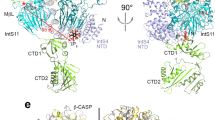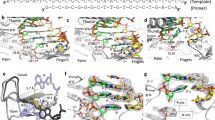Abstract
We have determined the solution structure of the DNA-binding domain of HIV-1 integrase by nuclear magnetic resonance spectroscopy. In solution, this carboxy-terminal region of integrase forms a homodimer, consisting of two structures that closely resemble Src-homology 3 (SH3) domains. Lys 264, previously identified by mutagenesis studies to be important for DNA binding of the integrase, as well as several adjacent basic amino acids are solvent exposed. The identification of an SH3-like domain in integrase provides a new potential target for drug design.
This is a preview of subscription content, access via your institution
Access options
Subscribe to this journal
Receive 12 print issues and online access
$189.00 per year
only $15.75 per issue
Buy this article
- Purchase on Springer Link
- Instant access to full article PDF
Prices may be subject to local taxes which are calculated during checkout
Similar content being viewed by others
References
Varmus, H.E. & Brown, P.O. in: Mobile DNA (eds Berg, D.E. & Howe, M.M.) 53–108 (American Society for Microbiology, Washington, D.C.; 1989).
Goff, S.P. Genetics of retroviral integration. A. Rev. Genet. 26, 527–544 (1992).
Vink, C. & Plasterk, R.H.A. The human immunodeficiency virus integrase protein. Trends Genet. 9, 433–437 (1993).
Katz, R.A. & Skalka, A.M. The retroviral enzymes. A. Rev. Biochem. 63, 133–173 (1994).
Withers-Ward, E.S., Kitamura, Y., Barnes, J.P. & Coffin, J.M. Distribution of targets for avian retrovirus DNA integration in vivo. Genes Dev. 8, 1473–1487 (1994).
Engelman, A. & Craigie, R. Identification of conserved amino acid residues critical for human immunodeficiency virus type 1 integrase function in vitro. J. Virol. 66, 6361–6369 (1992).
Bushman, F.D., Engelman, A., Palmer, I., Wingfield, P. & Craigie, R. Domains of the integrase protein of human immunodeficiency virus type 1 responsible for polynucleotidyl transfer and zinc binding. Proc. natn. Acad. Sci. U.S.A. 90, 3428–3432 (1993).
Vink, C., Oude Groeneger, A.A.M. & Plasterk, R.H.A. Identification of the catalytic and DNA-binding region of the human immunodeficiency virus type I integrase protein. Nucleic Acids Res. 21, 1419–1425 (1993).
van Gent, D.C., Vink, C., Oude Groeneger, A.A.M. & Plasterk, R.H.A. Complementation between HIV integrase proteins mutated in different domains. EMBO J. 12, 3261–3267 (1993).
Engelman, A., Bushman, F.D. & Craigie, R. Identification of discrete functional domains of HIV-1 integrase and their organization within an active multimeric complex. EMBO J. 12, 3269–3275 (1993).
Burke, C.J. et al. Structural implications of spectroscopic characterization of a putative zinc finger peptide from HIV-1 integrase. J. biol. Chem. 267, 9639–9644 (1992).
van Gent, D.C., Oude Groeneger, A.A.M. & Plasterk, R.H.A. Mutational analysis of the integrase protein of human immunodeficiency virus type 2. Proc. natn. Acad. Sci. U.S.A. 89, 9598–9602 (1992).
Vincent, K.A., Ellison, V., Chow, S.A. & Brown, P.O. Characterization of human immunodeficiency virus type 1 integrase expressed in Escherichia coli and analysis of variants with amino-terminal mutations. J. Virol. 67, 425–437 (1993).
Dyda, F. et al. Crystal structure of the catalytic domain of HIV-1 integrase: similarity to other polynucleotidyl transferases. Science 266, 1981–1986 (1994).
Yang, W. & Steitz, T.A. Recombining the structures of HIV integrase, RuvC and RNase H. Structure 3, 131–134 (1995).
Plasterk, R.H.A. The HIV integrase catalytic core. Nature struct. Biol. 2, 87–90 (1995).
Khan, E., Mack, J.P.G., Katz, R.A., Kulkosky, J. & Skalka, A.M. Retroviral integrase domains: DNA binding and the recognition of LTR sequences. Nucleic Acids Res. 19, 851–860 (1991).
Mumm, S.R. & Grandgenett, D.P. Defining nucleic acid-binding properties of avian retrovirus integrase by deletion analysis. J. Virol. 65, 1160–1167 (1991).
Woerner, A.M., Klutch, M., Levin, J.G. & Marcus-Sekura, C.J. Localization of DNA-binding activity of HIV-1 integrase to the C-terminal half of the protein. AIDS Res. Hum. Retr. 8, 297–304 (1992).
Puras Lutzke, R.A., Vink, C. & Plasterk, R.H.A. Characterization of the minimal DNA-binding domain of the HIV integrase protein. Nucleic Acids Res. 22, 4125–4131 (1994).
Nilges, M., Clore, G.M. & Gronenborn, A.M. Determination of three-dimensional structures of proteins from interproton distance data by dynamical simulated annealing from a random array of atoms-Circumventing problems associated with folding. FEBS Lett. 239, 129–136 (1988).
Brünger, A.T. X-PLOR, version 3.1: A system for X-ray crystallography and NMR (Yale University Press, New Haven, CT; 1992).
Musacchio, A., Noble, M., Pauptit, R., Wierenga, R. & Saraste, M. Crystal structure of a Src-homology 3 (SH3) domain. Nature 359, 851–855 (1992).
Yu, H. et al Solution structure of the SH3 domain of Src and identification of its ligand-binding site. Science 258, 1665–1668 (1992).
Kuriyan, J. & Cowburn, D. Structures of SH2 and SH3 domains. Curr. Opin. struct. Biol. 3, 828–837 (1993).
Cohen, G.B., Ren, R. & Baltimore, D. Modular binding domains in signal transduction proteins. Cell 80, 237–248 (1995).
Wilson, K.P., Shewchuk, L.M., Brennan, R.G., Otsuka, A.J. & Matthews, B.W. Escherichia coli biotin holoenzyme synthetase / bio repressor crystal structure delineates the biotin- and DNA-binding domains. Proc. natn. Acad. Sci. U.S.A. 89, 9257–9261 (1992).
Folkers, P.J.M., Folmer, R.H.A., Konings, R.N.H. & Hilbers, C.W. Overcoming the ambiguity problem encountered in the analysis of nuclear Overhauser magnetic resonance spectra of symmetric dimer proteins. J. Am. chem. Soc. 115, 3798–3799 (1993).
Burgering, M.J.M., Boelens, R., Caffrey, M., Breg, J.N. & Kaptein, R. Observation of inter-subunit nuclear Overhauser effects in a dimeric protein - Application to the Arc repressor. FEBS Lett. 330, 105–109 (1993).
Folmer, R.H.A., Hilbers, C.W., Konings, R.N.H. & Hallenga, K.A. 20 13C double-filtered NOESY with strongly reduced artefacts and improved sensitivity. J. biomol. NMR 5, 427–432 (1995).
Lee, W., Revington, M.J., Arrowsmith, C. & Kay, L.E. A pulsed field gradient isotope-filtered 3D 13C HMQC-NOESY experiment for extracting intermolecular NOE contacts in molecular complexes. FEBS Lett. 350, 87–90(1994).
Maignan, S. et al. Crystal structure of the mammalian Grb2 adaptor. Science 268, 291–293 (1995).
Feng, J.-A., Johnson, R.C. & Dickerson, R.E. Hin recombinase bound to DNA: the origin of specificity in major and minor groove interactions. Science 263, 348–355 (1994).
Liu, T., DeRose, E.F. & Mullen, G.P. Determination of the structure of the DNA-binding domain of γδ resolvase in solution. Prot. Sci. 3, 1286–1295 (1994).
Clubb, R.T. et al. A novel class of winged helix-turn-helix protein: the DNA-binding domain of Mu transposase. Structure 2, 1041–1048 (1994).
Baumann, H., Knapp, S., Lundbäck, Th., Ladenstein, R. & Härd, T. Solution structure and DNA-binding properties of a thermostable protein from archaeon Sulfolobus solfataricus. Nature struct. Biol. 1, 808–819 (1994).
Saksela, K., Cheng, G. & Baltimore, D. Proline-rich (PxxP) motifs in HIV-1 Nef bind to SH3 domains of a subset of Src kinases and are required for the enhanced growth of Nef+ viruses but not for down-regulation of CD4. EMBO J. 14, 484–491 (1995).
Murphy, J.E. & Goff, S.P. A mutation at one end of moloney murine leukemia virus DNA blocks cleavage of both ends by the viral integrase in vivo. J. Virol. 66, 5092–5095 (1992).
Matthews, S.J. & Leatherbarrow, R.J. The use of osmolytes to facilitate protein NMR spectroscopy. J. biomol. NMR 3, 597–600 (1993).
Vis, H. et al. 1H, 13C and 15N resonance assignments and secondary structure analysis of the HU protein from Bacillus stearothermophilus using two- and three-dimensional double- and triple-resonance heteronuclear magnetic resonance spectroscopy. Biochemistry 33, 14858–14870 (1994).
Bax, A. & Grzesiek, S. Methodological advances in protein NMR. Acc. chem. Res. 26, 131–138 (1993).
Clore, G.M. & Gronenborn, A.M. Multidimensional heteronuclear nuclear magnetic resonance of proteins. Meth. Enzymol. 239, 349–363 (1994).
Kay, L.E., Keifer, P. & Saarinen, T. Pure absorption gradient enhanced heteronuclear single quantum correlation spectroscopy with improved sensitivity. J. Am. chem. Soc. 114, 10663–10665 (1992).
Nilges, M. A calculation strategy for the structure determination of symmetric dimers by 1H NMR. Proteins 17, 297–309 (1993).
Laskowski, R.A., MacArthur, M.W., Moss, D.S. & Thornton, J.M. PROCHECK: a program to check the stereochemical quality of protein structures. J. appl. Cryst. 26, 283–291 (1993).
Kabsch, W. & Sander, C. Dictionary of protein secondary structure: pattern recognition of hydrogen-bonded and geometrical features. Biopolymers 22, 2577–2637 (1983).
Holm, L. & Sander, C. Protein structure comparison by alignment of distance matrices. J. molec. Biol. 233, 123–138 (1993).
Kraulis, P.J. MOLSCRIPT: a program to produce both detailed and schematic plots of protein structures. J. appl. Crystallogr. 24, 946–950 (1991).
Author information
Authors and Affiliations
Rights and permissions
About this article
Cite this article
Eijkelenboom, A., Puras Lutzke, R., Boelens, R. et al. The DNA-binding domain of HIV-1 integrase has an SH3-like fold. Nat Struct Mol Biol 2, 807–810 (1995). https://doi.org/10.1038/nsb0995-807
Received:
Accepted:
Issue Date:
DOI: https://doi.org/10.1038/nsb0995-807
This article is cited by
-
Structure and function of retroviral integrase
Nature Reviews Microbiology (2022)
-
INI1/SMARCB1 Rpt1 domain mimics TAR RNA in binding to integrase to facilitate HIV-1 replication
Nature Communications (2021)
-
Influence of the amino-terminal sequence on the structure and function of HIV integrase
Retrovirology (2020)
-
Structural dynamics of native and V260E mutant C-terminal domain of HIV-1 integrase
Journal of Computer-Aided Molecular Design (2015)
-
Crosslinking and mass spectrometry suggest that the isolated NTD domain dimer of Moloney murine leukemia virus integrase adopts a parallel arrangement in solution
BMC Structural Biology (2013)



